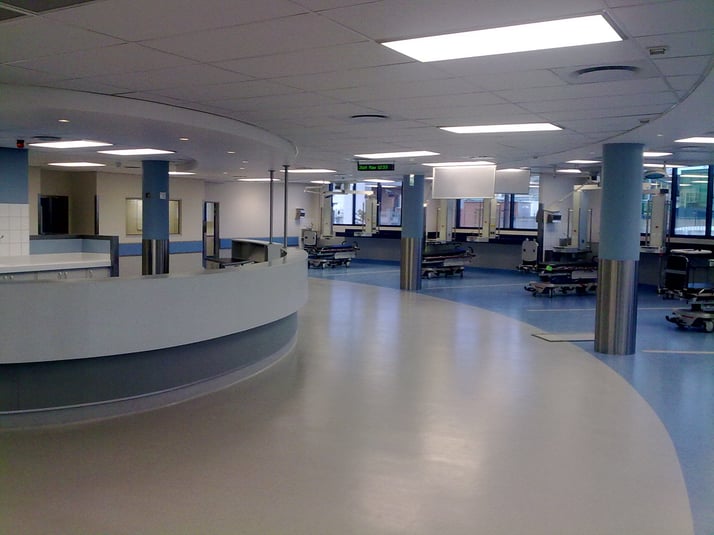Following a master plan for Livingstone Hospital drawn up in 2008 as part of the proposal to rationalise medical services in the Nelson Mandela Metropole, a new Accident & Emergency Unit was proposed to replace the existing Casualty at Livingstone Hospital in Port Elizabeth.
As a host city for the 2010 FIFA Soccer World Cup, Port Elizabeth had written into its hosting agreement that a new Accident & Emergency Unit had to be provided, as the existing unit was not up to an acceptable standard.

Consequently, the consultant team for the master plan, Brinkman Ndayi McAll cc – a multi-disciplinary Built Environment Consultancy that is recognised as specialist in the design of healthcare facilities – was appointed for the design and construction of the new unit.
The new A&E unit has a total floor area of approximately 12 000 m² and, as part of the new unit, a new Central Utility Building and a 2-bed Infectious Diseases Isolation unit were also constructed.
As a precursor to this unit, a R60-million temporary works and demolitions contract was signed to provide temporary accommodation and services in order to demolish the unused Maternity Unit and clear the site for the new facility. Also, the kitchen’s leaking roof was replaced, part of the cooking area overhauled and the ablutions in the Main Ward block renovated.
The Provincial Department of Roads & Public Works, on behalf of the Provincial Department of Health, provided the client brief, which was for a new Accident & Emergency facility catering for accident patients, walk-in casualty patients and medical emergency patients.
Two trauma theatres were required and supporting diagnostic digital X-Ray facilities. Ambulances required direct access to the accident area and, due to previous gang-related violence experienced in the old Casualty, security was of paramount importance.
Consequently the whole facility is access controlled and there are over 100 surveillance security cameras linked to the CCTV control room. In the event of a security crisis, the doors leading from the public waiting area into the clinical areas can be locked down to prevent unwanted ingress.
Additional requirements were for a new mortuary and the later addition of Trauma Wards, a new ICU and new High-Care facility to be catered for .
The building needed to complement the existing hospital, whilst creating a public image that uplifted the facility from the typical public perceptions of the hospital that abounded at the time.
To that end, finishes and specifications needed to be robust from a durability and maintenance perspective, but the design team also strove for strong aesthetic appeal in order to break down the stereotype associated with state medical facilities and to humanise the experience as much as possible.
Commenting on this project, Bryan Brinkman said, “We relied heavily on Polyflor’s ability to offer both hygienic and practical solutions that have a major impact on the ‘feel’ of a hospital. When it is part of a complete design concept, the correct floor can even aid the healing process. However, there are also the very important hygiene and safety aspects that need to be taken into consideration that are vitally important in achieving a positive contribution to patient care.”
“Polyflor became a vital partner in this process with their broad palette of contemporary colours and stone and wood ranges which helped us to reduce the clinical feel of parts of the building. Extensive control of volume via ceiling bulkheads and the use of colour on the vinyl floor to separate clinical treatment areas from circulation helps define function and hierarchy in the different components of the building,” he said. In order to create freedom to design a dedicated facility it was decided to demolish the under-utilised old Maternity wing and relocate the Korsten Clinic from the south-east corner of the site. This would enable the eastern flank of the hospital site to be used for the new A&E unit, but required significant decanting of buildings, departments and services under the Temporary Works & Demolitions contract in order to prepare the site.
Meanwhile, the hospital had to remain a fully functional facility with minimum disruption to services, staff and patients. This entailed a rework of the master plan proposal so that the work could be tailored to fit the available time.
Environment
The brief given to the consultant team by the Department of Health was that contemporary and future trends in the functioning of hospitals and its inherent technology were to be considered.
Careful orientation and choice of glazing materials and shading devices limit solar gain, while flooding the main public foyer with natural light. Artificial lighting is virtually all controlled by movement sensors and switches off after a determined period of time without movement in order to reduce wasteful electrical consumption.
Water is pre-heated using solar panels prior to being heated to the desired temperature. The floorcoverings used have a BRE ‘A+’ Rating and are LEED-certified; they contain 25% recycled product and are 100% recyclable at end of life. PUR coatings allow for reduced maintenance thus saving on water and chemicals.
See how Polyflor provided Chris Baragwanath Hospital with vinyl flooring and wall protection to a new unit with hygienic functional benefits and aesthetic advantages here.
For more insights like these sign up for Polyflor Insights and we will send useful tips and advice straight to your inbox.
